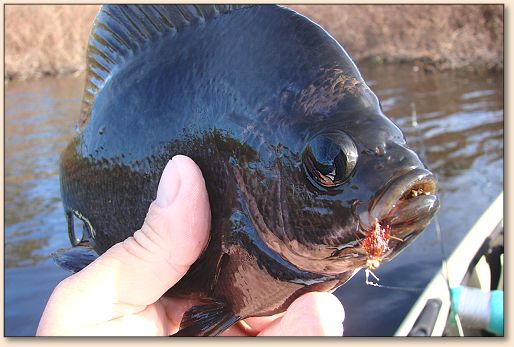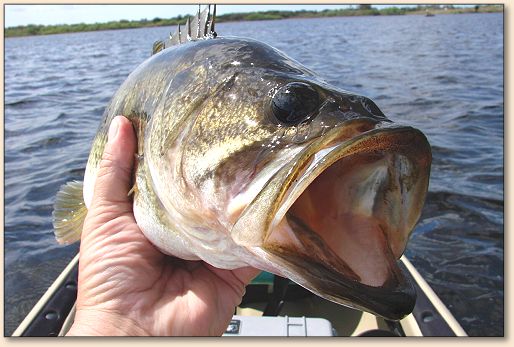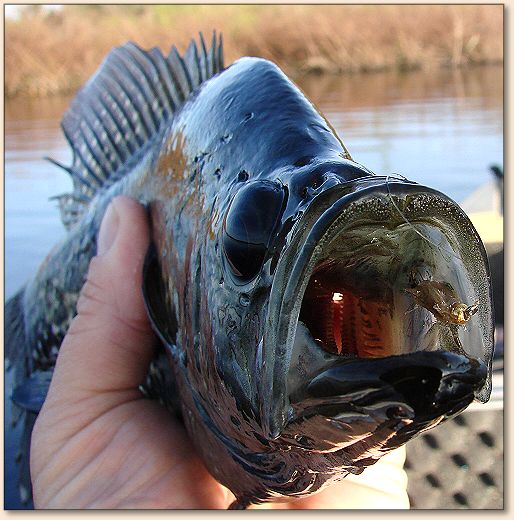|
There's no worry about ice on the lakes in south Florida.
So, we can pretty much fish the same techniques year round.
However, if we get a severe cold front passing through,
a change might be in order.
My specialty is panfish. There's nothing better than watching
a hand–sized bluegill pluck a No. 10 popping bug off the
surface. And every once in a while, you'll tie into a bass of
4 pounds or more.
Floridians traditionally will stick with popping bugs through
thick and thin, hell or high water or until death do they part.
When the topwater bite comes to a halt, that usually signals
the end of the outing.
Open any Floridian's fly box and you'll discover No. 10 poppers
in white, chartreuse, yellow and black. You'll see a similar
assortment of No. 8s and No. 12.
Oh, you might find a couple of woolly buggers, but you can
pretty much bet the hooks are rusty.
We're not talking about all fly anglers in the Sunshine State,
but you would be safe wagering that it's a majority.
When the topwater bite ends, it's not time to pack up and head
home. That only signals it's time to change approaches.
I love topwater as much as anyone. And I'll cast poppers from
sunup to sundown as long as the fish are receptive to my effort.
But when that bite ends, I'll just pick up another rod and begin
casting subsurface flies. My choices include my Myakka Minnow,
No. 12 bead-head nymphs and No. 12 scuds.
Sinking panfish flies don't have to be fancy. The fish are
usually picky. As long as the fly imitates a minnow or looks
buggy, you're in business.

I usually fish out of my Native Watercraft Ultimate 14.5.
It's the perfect platform to fish most medium to small
Florida lakes. You can't get a quieter approach.
I run Southern Drawl Kayak Fishing (www.kayakfishingsarasota.com)
in Sarasota, Fla., and I do a lot of guiding in salt water. However,
when I get a free day, you'll usually find me on Lake Manatee, a
2,500-acre lake located nine miles east of Interstate 75 off State
Road 64 in Manatee County.
The lake is surprisingly underfished. It's a rare occasion that
I see more than three boats.
I usually carry three fly rods: 1–weight, 2–weight and
3–weight. I'll toss poppers on the 3, put a Myakka Minnow
on the 2 and a No. 12 nymph on the 1.
I'll add a strike indicator above the Myakka Minnow and the nymph.
I've discovered that you'll recognize more strikes with the
indicator than without.
It's time to set the hook whenever the indicator does something different.
If it seems to pause, set the hook.
If it twitches, set the hook.
If you're stripping slowly and it doesn't move, set the hook.
If it goes under, set the hook.
I usually attach the indicator about 4½ to 5 feet above the
fly, depending, of course, on the depth of the water.
This time of year, Lake Manatee is alive with bluegill,
shellcracker, largemouth bass, speckled perch (crappie)
and channel catfish.
Though the lake has a good population of bass, I rarely
target them. Instead, I just fish for panfish. And I've
caught a number of big bass on tiny flies while doing so.
Last time out, I caught and released 50 hand–size bluegill,
10 speckled perch to 2 pounds and a healthy 4–pound
largemouth. All were taken on nymphs and my trusty 1–weight
TFO.
I'd lost a healthy bass in the brush earlier in the day.
That bass hit a nymph and ran toward the open lake, giving
me hope that I would land the fish. But it suddenly darted
toward the trees and broke my light tippet.
For most of my fishing, I'll use 5X tippet (about 4–pound test).
Fortunately, the second bass headed for open water and
remained there throughout the battle. Turned out to be
my biggest bass ever on a 1–weight.

The specks were the surprise of the day. They were in the
shallows in preparation to spawn. If you caught one, you
could rest assured there would be more in the same area.
I was taken by surprise how strong they were. The averaged
nearly 2 pounds and certainly didn't give up without a battle.

Last fall, I took Kevin Cooke, who runs Casey Key Anglers and
Outfitters in Nokomis, to Lake Manatee. He fished out of one
of my Heritage Redfish 14s. In addition to the usual assortment
of panfish, he connected with a hefty Manatee channel cat. He
hooked the fish on a No. 8 woolly bugger. After a lengthy battle,
he lost the fish in the trees.
A week later, I was fishing alone just west of the area where
Cooke had hooked his cat. I felt a hit, set the hook and held
on as the fish headed for the middle of the lake, taking me
deep into my backing. Until then, I thought the backing's
primary purpose on a freshwater outfit was to help fill the spool.
Unfortunately, I lost the fish (I'm sure it was a hefty channel cat)
when the hook pulled.
Lake Manatee also has a decent population of sunshine bass,
a cross between a white bass and a striped bass. I rarely
encounter sunshines, though.
A typical day on the lake is 100 fish. When the water's cold,
the fish slow down and a good day is 50 fish.
When fishing Florida freshwater lakes and streams, alligators
are a concern. In fact, they inhabit most every body of fresh
water around. I've never experienced any problem, but I respect
them just the same. It's not a good idea to tie a stringer of
fish to your vessel.
In most case, gators in the wild will swim away whenever you're
in the area. Mangrove Coast Fly Fishers' (www.mangrovecoastflyfishers.com)
president Bob Parker accompanied me on a trip to the lake last
fall. His purpose was twofold: 1. He wanted to see if kayak
fishing was for him; 2. He wanted to discover the world of Florida
freshwater fishing.
He fell in love with both. Parker now owns a Heritage Redfish
14 and spends quite a bit of time, fly-fishing fresh water.
The lake offers plenty of shoreline, and you can find calm water
no matter what the direction of the wind.
Last fall, I was surprised by high water when I arrived at the
ramp located at Lake Manatee Fish Camp. The water was up in the
parking lot. We'd experienced a substantial amount of rain the
day prior. It was dark, however, and I didn't notice the muddy
water until after the sun came up.
I knew something was wrong because I was getting no action on my popping bug.
I paddled to a nearby cove and found the water clean and calm.
But I still wasn't getting any action on my popper.
So, I picked up the 1–weight and began casting a small nymph.
I stayed in that cove for four hours and caught plenty of bluegill
and a few nice bass.
When the topwater bite ends, it's not the signal that the day's
over. It's the signal that the action's only going to get better
when you make the subsurface switch. ~ Steve
About Steve:
Steve Gibson is a professional outdoor writer and kayak
fishing guide who resides in Sarasota, Fla., his work
has appeared in Florida Sportsman, Saltwater Fly Fishing,
Fly Fishing in Salt Waters, Gulf Coast Angler, Florida
Fishing Weekly, Cabela's Online Magazine and other
publications. Born in Huntington, W.VA., he graduated
in 1971 from Marshall University with a B.A. in Journalism.
He served in the United States Air Force from 1971 to 1975.
He has been the outdoor editor of the Sarasota Herald–Tribune
for the past 32 years. He resides in Sarasota, Fla., with his
wife, Kathy, and their Jack Russell Terrier, Jack. His website
is www.kayakfishingsarasota.com.
|



